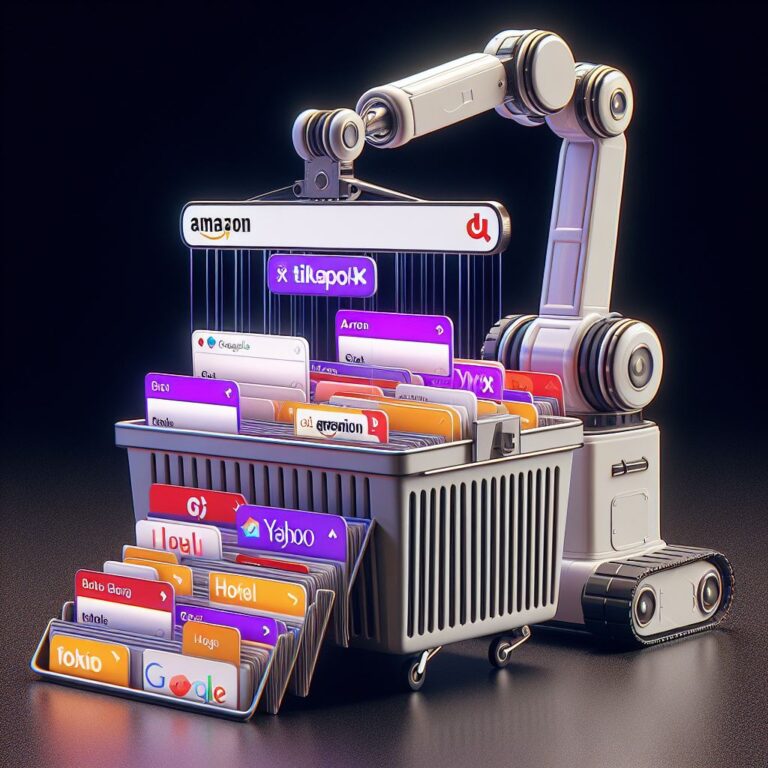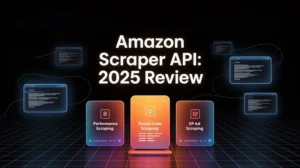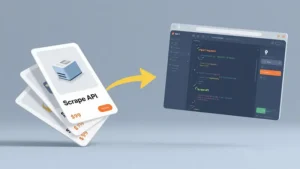In the current wave of digitization sweeping the global business arena, e-commerce platforms, with their boundaryless transactions and massive data advantages, are increasingly becoming crucial grounds for businesses to gain insights into market trends and optimize product strategies. Among them, Amazon, as the world’s largest online retailer, harbors a wealth of valuable information treasure troves including product details, user reviews, sales data, and more.
However, these valuable data are not readily available but are deeply embedded within complex web structures, waiting for knowledgeable individuals to collect Amazon data through web scraping and transform it into insights and competitive advantages. This article aims to guide readers from scratch, gradually delving into practical examples and code, to reveal how to use programming languages like Python and related tools to successfully scrape various types of data from the Amazon platform. It also discusses the challenges encountered, response strategies, and the application value of professional solutions like Pangolin Scrape API in this process.
Next, we will unfold a detailed explanation in order from the basics to advanced strategies, and then to complex solutions for dealing with large-scale, real-time, and dynamic environments. Simultaneously, we will introduce the Pangolin Scrape API as a professional tool, analyzing its significant advantages in simplifying the data scraping process, improving efficiency, and reducing costs. We’ll also discuss whether it constitutes a more professional and economical choice compared to self-built scraping teams in specific scenarios.
The entire article aims to provide readers with a comprehensive and practical guide to Amazon data scraping, assisting you in accurately navigating and efficiently mining the ocean of e-commerce big data.
I. Basics: Exploring Amazon Data Scraping
Understanding Objectives and Choosing Tools
Before embarking on any web scraping project, it is crucial to clearly define the scraping objectives as the first step. For Amazon platform data scraping, possible objectives include but are not limited to:
- Product details (such as name, price, stock, ASIN code, UPC/EAN code, category, brand, etc.)
- User reviews (content, rating, review time, user ID, number of likes, etc.)
- Sales ranking and historical price trends
- Market competition (competitor information, similar product lists, seller information, etc.)
Defining specific objectives helps in selecting appropriate scraping methods, designing data structures, and writing efficient scraping code.
1.2 Choosing Suitable Tools and Technology Stack
When scraping Amazon data, the following technology stack is commonly used:
Programming Language: Python is the preferred language for data analysis and web scraping development, with rich library support such as requests, BeautifulSoup, Selenium, Scrapy, etc. HTTP Request Library: Requests is used to send HTTP requests to retrieve web page content, it is concise, easy to use, and powerful. HTML Parsing Library: BeautifulSoup is used to parse HTML documents and extract the required data elements. It efficiently completes tasks for simple static pages. Browser Automation Tool: Selenium, along with WebDriver, simulates real user behavior, suitable for handling dynamically loaded content, executing JavaScript, or scenarios requiring login authentication. Scraping Framework: Scrapy provides a complete set of scraping development processes, including request scheduling, data parsing, middleware processing, persistent storage, etc., suitable for large and complex scraping projects.
Example Code: Scraping basic product information using requests library and BeautifulSoup
pythonCopy codeimport requests
from bs4 import BeautifulSoup
def scrape_amazon_basic_info(url):
headers = {
'User-Agent': 'Mozilla/5.0 (Windows NT 10.0; Win64; x64) AppleWebKit/537.36 (KHTML, like Gecko) Chrome/99.0.4844.51 Safari/537.3'
}
response = requests.get(url, headers=headers)
soup = BeautifulSoup(response.text, 'html.parser')
title = soup.find('span', {'id': 'productTitle'}).text.strip()
price = soup.find('span', {'class': 'a-offscreen'}).text.strip()
return {
'title': title,
'price': price
}
url = 'https://www.amazon.com/dp/B08H93ZRKZ' # Example product link
print(scrape_amazon_basic_info(url))
Challenges and Solutions:
Anti-scraping Mechanisms: Large e-commerce platforms like Amazon have strict anti-scraping measures such as IP restrictions, User-Agent detection, CAPTCHA, etc. Solutions include using proxy IP pools, randomizing User-Agent, handling CAPTCHA services (such as OCR), etc. Dynamic Loading: Product information may be dynamically loaded via AJAX, making direct HTML requests inadequate. The strategy is to use browser automation tools like Selenium, Playwright, etc., to simulate user behavior, or parse AJAX requests directly to fetch data.
II. Advanced: Handling Complex Structures and Bulk Scraping
Dealing with multiple pages, attributes, and efficient scraping strategies
Example Code: Implementing product list and detail page scraping using Scrapy framework
pythonCopy codeimport scrapy
class AmazonProductSpider(scrapy.Spider):
name = 'amazon_products'
start_urls = ['https://www.amazon.com/s?k=tunic+tops+for+women']
def parse(self, response):
for product in response.css('.s-result-item'):
yield {
'title': product.css('.a-text-normal::text').get(),
'link': product.css('a::attr(href)').get(),
}
next_page = response.css('li.a-last a::attr(href)').get()
if next_page is not None:
yield response.follow(next_page, self.parse)
def parse_product_details(self, response):
yield {
'title': response.css('#productTitle::text').get(),
'price': response.css('#priceblock_ourprice::text').get(),
# ... Other detailed information scraping
}
def parse(self, response):
for product in response.css('.s-result-item'):
link = product.css('a::attr(href)').get()
yield response.follow(link, self.parse_product_details)
next_page = response.css('li.a-last a::attr(href)').get()
if next_page is not None:
yield response.follow(next_page, self.parse)
Challenges and Solutions:
Deep Scraping and Association: Product detail pages may involve multiple levels of page navigation, requiring recursive scraping logic design. Scrapy‘s Request and callback functions can be used to achieve this. Data Cleaning and Standardization: Different product data structures require generic or targeted data cleaning rules to ensure uniform data storage.
III. Complex: Dealing with Large-Scale, Real-Time, and Dynamic Environments
Distributed scraping, data stream processing, and dynamic adaptation strategies
Example Code: Integrating Celery asynchronous task queue with Docker containerization deployment
yamlCopy code# Using Celery to configure the task queue
# Sample docker-compose.yml configuration
version: '3'
services:
scraper:
build: .
command: celery -A scraper worker --loglevel=info
redis:
image: redis:latest
ports:
- "6379:6379"
pythonCopy code# Integrating Celery into Scrapy project
# settings.py
BROKER_URL = 'redis://redis:6379/0'
CELERY_RESULT_BACKEND = 'redis://redis:6379/0'
# tasks.py
from celery import shared_task
from scrapy.crawler import CrawlerProcess
from scrapy.utils.project import get_project_settings
@shared_task
def run_spider(spider_name):
process = CrawlerProcess(get_project_settings())
process.crawl(spider_name)
process.start()
# Calling tasks
run_spider.delay('amazon_products')
Challenges and Solutions:
Scaling and Efficiency: Facing massive data, single-machine scraping efficiency is limited. Using distributed crawlers (like Scrapy-Redis) to distribute tasks and parallelize scraping across multiple machines. Real-Time Requirements: Real-time monitoring of data changes requires incremental scraping. Combine database storage of scraped data status and only scrape updated content.
IV. Professional Solution: Pangolin Scrape API
Integrated service advantages, feature analysis, and cost-effectiveness analysis
Pangolin Scrape API (https://pangolinfo.com/) is an API service designed specifically for large-scale, high-efficiency e-commerce data collection. It encapsulates complex scraping technologies and anti-anti-scraping strategies. Users can obtain the required Amazon data through simple HTTP requests, greatly simplifying the data collection process.
Instant Usability: No programming skills required, simply obtain the required data through simple HTTP requests, saving development and maintenance costs. Anti-Scraping Protection: Built-in advanced proxy management and intelligent request strategies effectively counter website anti-scraping mechanisms, ensuring stable scraping. Rich Interfaces: Covering various data types such as product listings, details, reviews, sales, rankings, etc., to meet diverse analysis needs. Real-Time Updates: Supports scheduled tasks and real-time data push to ensure data timeliness and accuracy. Large-Scale Concurrency: Cloud-native architecture supports large-scale distributed scraping to meet high throughput requirements. Customized Services: Provide personalized data customization and technical support for specific business scenarios.
Comparison between Pangolin Scrape API and self-built scraping teams:
Professionalism: Pangolin focuses on e-commerce data scraping, with a deep understanding of platform characteristics and anti-scraping strategies, enabling rapid response to website changes. Self-built teams require continuous investment in learning and research, and professionalism may be limited by experience accumulation. Economy: Using API services only requires pay-as-you-go, avoiding the fixed costs of self-built teams such as manpower, hardware, and operations, especially suitable for short-term projects or small to medium-scale requirements. For long-term large-scale scraping or highly customized requirements, the marginal cost of self-built teams may be lower. Stability: API services typically provide SLA guarantees, ensuring service availability and data quality. Self-built teams need to build monitoring, fault recovery, and other systems themselves, and stability depends on team technical level and operational investment.
Conclusion:
Pangolin Scrape API, with its convenience, professionalism, and economy, is one of the more professional and economical choices for non-professional development teams, rapid prototyping, small to medium-scale projects, or short-term data needs. For large-scale, highly customized, or long-term stable scraping requirements, enterprises need to weigh the long-term investment of self-built teams against API service costs, considering factors such as technical capabilities, budgets, project cycles, etc.







